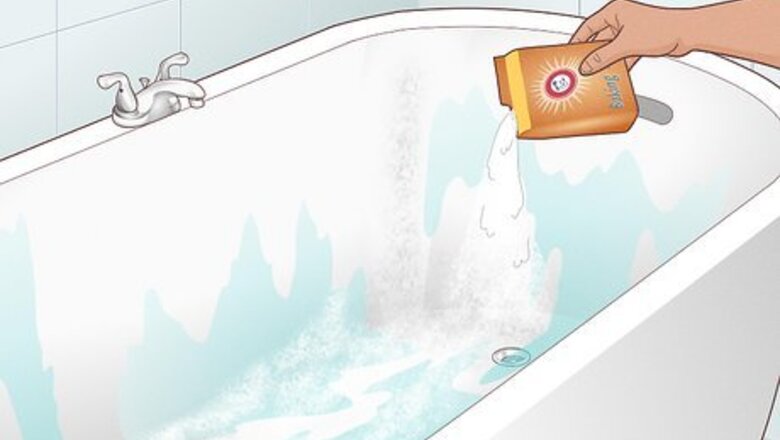
views
Using Dish Soap & Baking Soda
Rinse your tub with water and sprinkle the surface with baking soda. Baking soda can get rid of mildew, soap scum, and rust. Rinse your tub with hot water to get rid of any dirt, hair, or debris. Sprinkle the walls and bottom of the bathtub with baking soda, making sure to cover the drain, the faucet, and the handles. Baking soda is a non-abrasive cleaner that can safely clean acrylic tubs.
Fill a bucket with hot water and dish soap, then scrub the tub. Fill a bucket with hot water and a couple of drops of a gentle dish soap. Dip a cloth or sponge in the solution and scrub the surface of the tub. If you notice any especially hard-to-get stains, sprinkle more baking soda directly on your sponge or cloth and scrub.
Rinse the tub with hot water and polish with a dry cloth. Rinse the entire tub with hot water. If there are still stains left behind, repeat this process. Use a soft dry cloth to dry the surface of the tub, the handles, and the faucet.
Using Shampoo
Wash the surface of the tub with a damp cloth and baby shampoo. Rinse any hair, dirt, or soap down the drain with warm water. Dip a damp cloth in baby shampoo and scrub the tub, making sure to wash the faucet, handles, and drain. Scrub the walls in circles and rinse the rag often to remove any accumulated soap. Repeat until the tub is clean. Alternatively, use your own shampoo. Shampoo can remove soap scum and add extra shine to chrome fixtures.
Rinse and dry the bathtub, and apply car wax if needed. Rinse the surface of the tub with warm water, making sure no residue is left behind. Use a clean dry rag to polish the surface of the tub.
Using Vinegar & Baking Soda
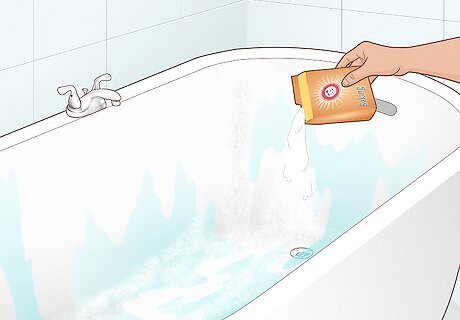
Scrub the tub with baking soda to remove soap scum and mild stains. Remove any toiletries and rinse the tub with water to remove any hair or leftover soap deposits. Sprinkle baking soda all over the wet surface of the tub. Use a sponge or cloth to scrub the tub—the baking soda will form a paste, removing soap scum, mildew, and stains. If you have large hard-to-clean stains, mix baking soda and water to create a paste, then use a sponge to apply it. Let it sit for 15 minutes, then rinse thoroughly with water.
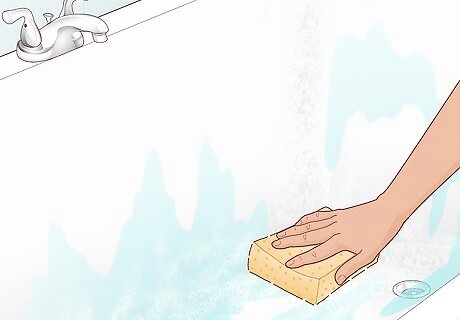
Spray the tub with vinegar and scrub with a cloth or soft sponge. Mix 2 parts water with 1 part vinegar in a spray bottle, spray the surface of the tub, and scrub the walls. You can also use a sponge dipped in the solution to scrub the walls. The vinegar will activate the baking soda to help remove any stains. Optionally, add a little bit of dish soap to the spray bottle to make sure no residue is left behind. Use an unused toothbrush to scrub around the faucets and in tight corners.
Rinse the bathtub and reapply baking soda if needed. Use a detachable shower head or fill a bowl with water to rinse down the walls of the bathtub until no baking soda or vinegar is left. Reapply baking soda to any leftover stains and scrub over them. Repeat until the entire tub is clean. To remove soap scum from the shower head, unscrew it and soak it in the vinegar water solution or tie a bag filled with vinegar around the head and let it soak for 30 minutes. Scrub the head with a toothbrush.
Using Lemon & Baking Soda
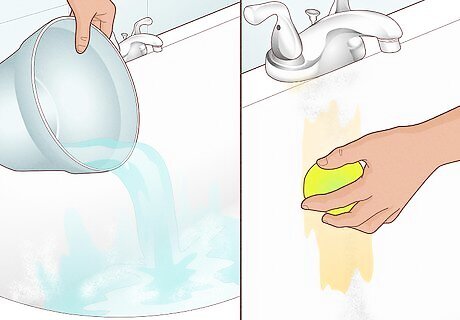
Wash the surface of the bathtub with lemon and baking soda. This works great if you’re looking to quickly scrub down your bathtub and treat soap scum stains. Wash any grime in the tub away with hot water. Cut a whole lemon in half and dip it in baking soda. Use the lemon to wash the tub, scrubbing any tough stains. Alternatively, mix 1 part baking soda and 1 part dish soap, then add a few drops of lemon juice. Scoop the mixture with a wet sponge and clean the tub from top to bottom.
Rinse the tub with water and scrub any leftover stains with the lemon. Rinse the entire tub down with hot water to remove all the leftover grime and baking soda. If any stains remain, repeat this process until they’re gone. To remove hard-water spots from your fixtures, rub a freshly cut lemon on them and buff with a clean cloth.
Using Vinegar
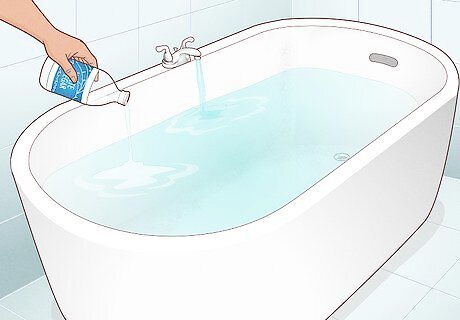
Fill the tub with hot water and vinegar to remove mold and mildew. Fill the tub with hot water and pour in 2 cups (470 mL) of distilled white vinegar. Let it sit for about 20 minutes and then drain the tub. Alternatively, add 1 part white vinegar and 1 part water to a spray bottle, then spray the surface of the tub. Wait 15 minutes, then scrub with a clean sponge. Optionally, add 1 tablespoon of dish detergent or gentle dish soap.
Scrub the bathtub with a sponge and rinse. Use a sponge or cloth to scrub the tub from top to bottom. Wash away any leftover vinegar with hot water, then use a dry cloth to polish the surface. Optionally, sprinkle baking soda over the tub and scrub with a bucket of warm water and dish soap to make sure no vinegar residue remains.
Using Hydrogen Peroxide & Baking Soda
Mix baking soda and hydrogen peroxide to clean tough stains. Baking soda and hydrogen peroxide are great for spot-treating mildew or mold spots. Make a paste with 2 parts baking soda and 1 part hydrogen peroxide, then use a sponge or cloth to apply it to the stains on your tub. Alternatively, make a paste with cream of tartar and hydrogen peroxide. This paste also makes a great grout cleaner for showers. Just add 1 teaspoon (4.9 mL) of dish soap and use a grout brush or old toothbrush to scrub around the tiles. Rinse the area with water.
Leave the paste for at least 30 minutes, then scrub and rinse the tub. Use a clean sponge or cloth to wipe the baking soda off the tub and rinse the walls with clean water. If a stain is still there, repeat these steps until it’s gone. After you’re done, wipe the tub down with a rag to make sure it’s dry.
Choosing Commercial Cleaning Products
Use a cream cleanser for regular everyday cleaning. A cream cleaner like Soft Scrub can get rid of soap scum and other stains. To get rid of heavy stains, apply the cleaner with a cloth or sponge and let it sit for at least 30 minutes before rinsing the area. When using any commercial cleaner, carefully read the label to make sure it’s safe for acrylic tubs.
Use a Magic Eraser or melamine sponge to clean tough stains. Wet a melamine sponge with water, squeeze it out, then scrub your entire bathtub, including any stubborn stains. Rinse any remaining product down the drain with hot water. Make sure the melamine sponge you buy doesn’t contain bleach.
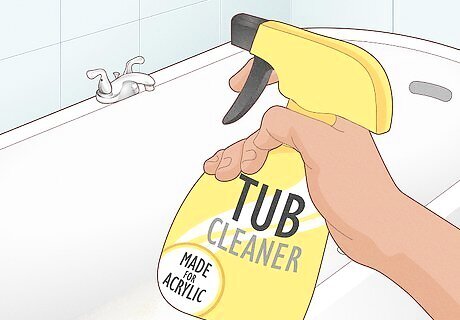
Choose a deep-cleaning product that’s safe for acrylic. Check the label on bathroom cleaners to make sure it’s safe on acrylic. You can also check with your tub manufacturer for a list of approved commercial cleaners to use on the tub. Here are some of the best cleaners for acrylic: Simple Green Bathroom Cleaner: Removes limescale and soap scum. Seventh Generation Tub & Tile Cleaner: Safe on acrylic (plastic), ceramic, chrome, fiberglass, and stainless steel. Formula 409 Multi-Surface Cleaner: Cuts grease and disinfects surfaces. Liquid Pine-Sol Original: Removes soap scum without leaving streaks.
Cleaning Products to Avoid Using on an Acrylic Tub
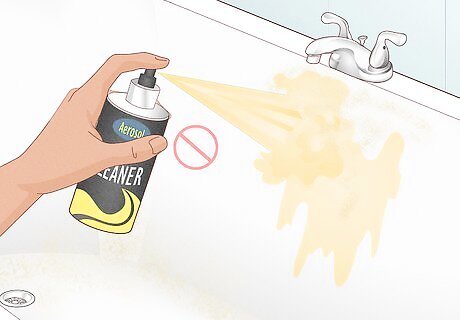
Try to avoid abrasive cleaners like bleach or ammonia. Acrylic tubs can become damaged easily with chemical cleaners. Try to avoid using aerosol cleaners that come in cans or solvents (like acetone) or harsh chemicals like bleach or ammonia.
Skip abrasive tools like pumice stones or steel wool. Cleaning tools like brushes, scrubbing pads, and the abrasive sides of sponges can cause scratches in your tub, To avoid damaging your bathtub, use a gentle sponge or a soft cloth to clean it.
Keeping Your Acrylic Tub Clean
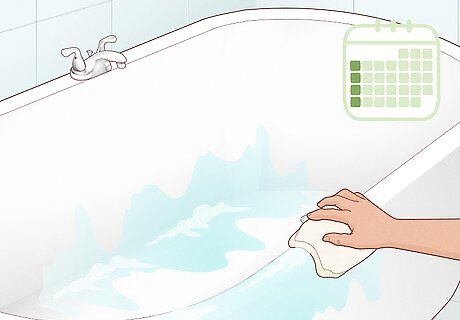
Clean your acrylic bathtub once a week. Use one of these methods once a week to keep your tub clean and mold and mildew-free. Regular washing will also keep stains from forming in the acrylic tub and tile near the tub.
Use a daily shower cleaner to prevent soap scum and mildew. Spray a daily shower cleaner over your tub and wipe it down with a sponge or cloth every day to prevent soap scum and other stains from forming. Apply the cleaner and dry the bath completely after you shower or bathe. Optionally, apply RainX (a car windshield water repellent) to your glass shower doors to keep them clean for longer.

Unclog your drain with a plastic snake or baking soda and vinegar. When your bathtub drains slowly or clogs completely, take the cover off the drain. Push a plastic drain snake down the pipe, twist, and pull up the clog. You can also pour ⁄2 cup (0.12 L) of vinegar down the drain, then chase it with 1 cup (0.24 L) of heated vinegar. Let it sit for 15 minutes, then run hot tap water. If you leave cleanser or clog remover in the drain area, it could damage the acrylic surface.
Protect your acrylic tub or shower with a sealant like car wax. Most minor scratches can be easily repaired. However, if you’d like to skip that process and protect your tub from future stains and scratches, dip a cloth in car wax and apply it to the surface in circular motions. To fix minor scratches, just sand them down with fine grit sandpaper and paint over the top with acrylic polish.
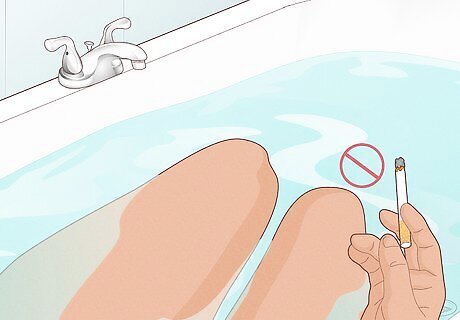
Try to avoid smoking around the tub. Heat and tobacco from cigarettes can stain and damage an acrylic tub. Try to avoid smoking in the tub or leaving cigarettes to burn on the edges. If you have cigarette burns or stains in your acrylic tub, you may need to sand and resurface the area.




















Comments
0 comment